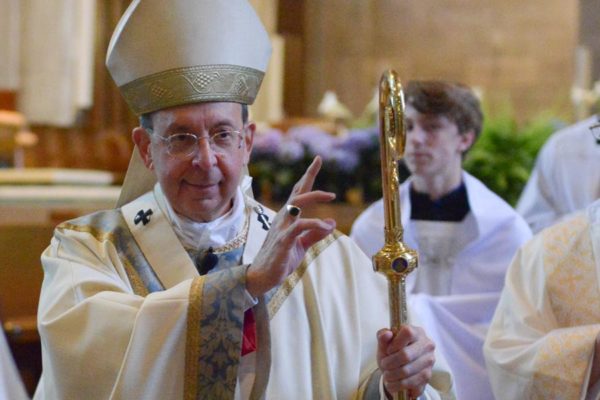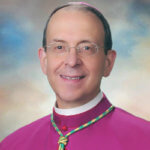5th Sunday in Ordinary Time
Borghese Chapel, St. Mary Major
Knights of Columbus Board Pilgrimage
Feb. 9, 2020
We are not just anywhere but here in the Eternal City, the City of Rome. St. Fulgentius of Ruspe, who hails from the 6th Century, put it this way: “Oh, how beautiful must be the heavenly Jerusalem if earthly Rome is so glorious!” And it seems to me that the beauty of Rome is found in concentrated form here at Saint Mary Major, in this Borghese Chapel, built in the 17th Century by Pope Saint Pius V. The early American novelist, Nathaniel Hawthorne, described this chapel thus: “Unless words were gems that would flame with many-colored light across the page, and throw thence a tremulous glimmer into the reader’s eyes, it would be vain to attempt a description of this princely chapel” (PWR).
It would, of course, be even more vain for me to attempt a description of this glorious chapel— its rare and priceless marbles, the depiction of the communion of saints, the statues of Pope St. Pius V and Pp. Clement II and the reliefs that surround them. But upon whom is the attention of those saints and pontiffs focused? Towards whom were the eyes of St. Francis Borgia, St. Stanislaus Kostka, St. Philip Neri, St. Charles Borromeo, and St. John Henry Newman drawn when they visited this chapel? And towards whom were our eyes drawn from the moment we entered this splendid place? Was it not the icon of Mary, the Mother of God: Maria Salus Populi Romani – literally, Mary, the health, the salvation of the Roman people.
This icon, arguably the most famous image of Mary in all the world, is more than a priceless artifact of Christian antiquity. It is linked to the Evangelist St. Luke who is said to have painted it, even as he painted a most beautiful portrait of Our Lady in his Gospel. Faithful to St. Luke’s Gospel, Mary is seen in this icon with her Child, the Incarnate Son of God, from whom every blessing flows.
In the Temple and on the Mountain
Just last week, we celebrated the Feast of the Lord’s Presentation in the Temple. St. Luke described for us how Mary, accompanied by Saint Joseph, entered the Temple, holding in her arms the Infant Jesus. Inspired by the Holy Spirit, Simeon, a layman in his advancing years, recognized Jesus as the long-awaited Savior, as the Messiah, the promised of ages. As Simeon took the Infant in his arms, he sang of him to the heavenly Father. He hailed Jesus as the salvation for which the people of Israel were longing and as the One who would reveal the light of God’s glory to all the nations. Simeon also revealed that Mary, like no one else, would share in Jesus’ sufferings. Her heart pieced with sorrow, she would become a conduit of grace and salvation, and thus every generation calls her blessed!
Just as St. Luke drew us into that precious scene in the Temple wherein Christ, the light of the world, illuminated the darkness, so too today, St. Matthew places us on the Mount of the Beatitudes where Jesus says to you and me: “You are the light of the world… your, i.e., our light must shine before others that they may see [our] good deeds and glorify [our] heavenly Father.” Jesus was the light of the world became he came among us as God’s Son, and in our humanity, he perfectly reflected the love of his heavenly Father. Jesus did this by preaching the Good News, curing the sick, expelling demons, raising the dead, and above all, by his own Death and Resurrection. If we would be “the light of the world” – if our light would shine in the darkness – then our actions, even more than our words, must reflect the love of Christ. Isaiah says that our light will “break forth like the dawn” if we share our bread with the hungry, shelter the oppressed and the homeless, if we clothe the naked, and never turn our back on our own. Simply put, dear friends, the Word of God this Sunday is urging us to live the principle of charity visibly, tangibly, practically, and robustly.
This is what we aspire to and this is who we are as Knights of Columbus. Yet, we know how hard it can be to imitate the love of Jesus. We know how short we fall in replicating Jesus’ love in our world and how easily the light of our love can flicker when we are tired or discouraged or distracted. For that reason, we must take to heart the words of St. Paul in our 2nd reading. As St. Paul went about his strenuous labors for the Gospel, he was entirely focused, not on his own wisdom or goodness, but rather on Jesus Christ and him crucified. Indeed, St. Paul’s words and deeds flowed not from his own wit and wisdom, but rather from the Holy Spirit who gave him strength for his mission and who infused his words and deeds with the power of God.
This is a lesson Mary learned from her earliest years. Throughout her life, Mary meditated on God’s Word in the power of the Spirit. As the Fathers of the Church often said, Mary conceived God’s Word in her heart before she conceived him in her womb. Her own spirit of charity toward her cousin Elizabeth, or toward the newly married couple at Cana, flowed from her life of prayer. So too, if we would do those good deeds that reflect the light of Christ, those works of charity that make us light in a darkened world, then we also must mediate on God’s Word, develop our life of prayer, and ask the Holy Spirit to infuse our words and deeds with his power.
The Principle of Charity
So, when we read the Word of God slowly and prayerfully, and when we pray the Rosary, seeing the mysteries of Jesus’ life through Mary’s eyes, then Isaiah’s words are fulfilled in us and in our beloved Order. From our prayer and meditation on the Word of God, and above all, from the Eucharist, we gain the insight, strength, and generosity to feed the hungry, shelter the oppressed and homeless, give warm winter coats to needy children, protect the unborn and vulnerable, defend the religious freedom of those who are oppressed. When we do all of these things and much more, then does our light and the light of the Knights of Columbus shine before others.
And because we daily meditate on the Word of God as did Mary, and because we consistently see Christ through the eyes of Mary, and above all, because Mary leads us, again and again, to the Eucharist, our works of charity participate in Jesus’ own ministry of health and healing, our works of charity participate also in Mary’s deep love for God’s People, indeed, her love for “all those who walk in darkness and the shadow of death”. Thus in the family of the Church and beyond, the Knights of Columbus has become a conduit of that salvation which Christ won for us and in which Mary participated so completely.
Our Eyes Fixed On Mary
We take part in Mass, the Paschal Sacrifice of the Incarnate Son of God, under the gaze of the Blessed Virgin Mary, “Salus Populi Romani”. To return her gaze is not to avert our eyes from Christ but rather to contemplate our spiritual Mother who, in the power of the Holy Spirit, brings forth Christ in us. By her prayers, her example, and her maternal care, we too can be “salus populi” in a world darkened by sin, by oppression, and division. And we do this every time we are true to the first principle of our Order, charity. Mary, Salus populi Romani – ora pro nobis!


